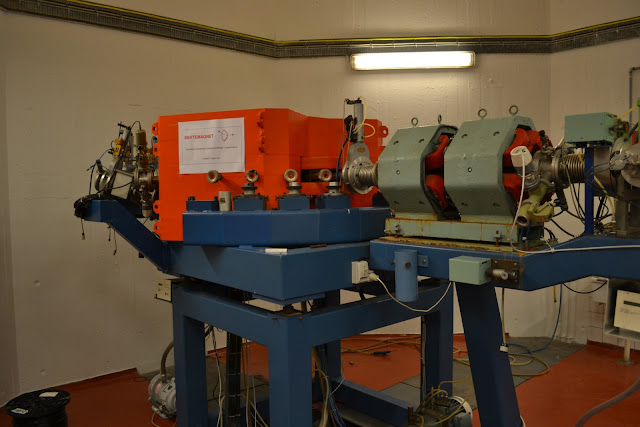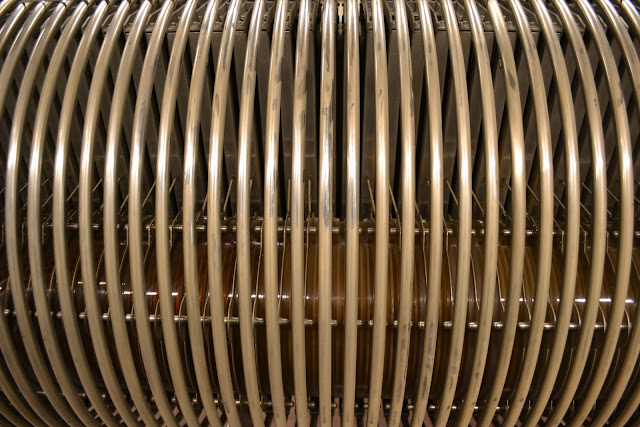The EN Tandem is the smaller brother of the FN Tandem by HVEC. Our EN was installed in Aarhus during the early 70ies. Our tour today starts in the control room of the accelerator:
 |
| Main control room. |
 |
| Ion source controls. |
 |
| Injector controls. |
The inflection magnetic field directs the beam from the active ion source to the Tandem accelerator. Addiational a chopper was there for attenuating the beam, along with electrostatic beam steerers. Two quadrupole pairs assures the focusing of the beam.
 |
| Beam current monitors. |
 |
| Accelerator controls. |
Inside the terminal you can install several kinds of strippers, either a gas stripper, or various foil strippers. The negative ions are here stripped by their electrons, then becoming positive and accelerated again from the positively charged terminal.
 |
| Analyzer magnet controls. |
| Beamline selection and focussing. |
And finally, after some additional tuning and focussing, you can select which beam line you want to use.
| Control logic |
 |
| Safety system bypass switches... |
This concludes our tour in the control room, next lets take a look at the accelerator vault. Depending on what kind of ion and what currents you operate with, the accelerator may create radiation. Mostly gammas, but occasionally also neutrons if you run e.g. high current protons. A massive concrete door slides aside...
 |
Once inside, you can see the Tandem accelerator (to the left) and the two ion sources to the right.
The ion source to the back next to the blue 19' rack, is a new ion source for C-14 dating. It contains a large wheel with dozens of carbon samples to be measured for C-14 contents. Also an airlock makes it possible to change the samples without breaking the vacuum.
Here is the old C-14 ion source which was used for many years. Both the new and the old ion source is a sputter ion source where Cesium ions are bombarding the carbon target, thereby releasing negatively charged ions.
The accelerator itself is a big pressurized tank containing a vaccum tube and the high voltage charging apparatus. The tank is filled with mix of dry Nitrogen and SF6 (stored in the tanks under the ceiling). Due the damage the accelerator suffered, it was depressurized for further inspections. So let's have a look inside...
Before you enter, you must make sure that proper venting is assured. There has been a casualty at another accelerator of this type, where people fainted and suffocated.
There are four manholes, where you can enter. You can see the ring structures which ensure a homogenous field gradient from the high voltage terminal.
Looking from the low energy section to the high energy section, you can just glimpse the terminal in the middle.
A part of the acceleration tube at the high energy section.
Once the beam exits the accelerator, it passes a quadrupole pair...

... and the orange analyzing magnet shown to the left.
Finally it passes another set of quadrupoles and the switching magnet, which directs the beam to one of the 8 beam lines.
Magnets are water cooled.
A water cooled beam dump.
Radiation detectors monitor the gamma and neutron field in the accelerator vault.
Signs tell if the accelerator is running, and if radiation is present.
 |
| Hand held radiation monitors. |
A movie of the explosion of one of the two radiation protection doors can be seen here:
http://owww.phys.au.dk/main/historie/blast002.avi
A damage report (in Danish only, but with fancy pictures) is here:
http://ing.dk/modules/fsArticle/download.php?fileid=968
This is the end of our tour at the Tandem accelerator.
The complete picture gallery with additional fotos was uploaded to picasa:
https://picasaweb.google.com/niels.bassler/TandemENAcceleratorAarhus?authuser=0&feat=directlink
If you are still reading this, you are welcome to drop by for a cup of coffee in my office upstairs.. :-)






































